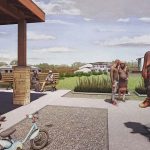Walk Through
We are building something really incredible here at True Craft, on every dimension; the team, the people, the product, the business growth, the ambition, the opportunity.
request a quote
Let’s walk through an example of
True Craft Architecture's
Process for helping developers close their potential Low-Income Housing 4% Tax Credit deal from start to finish:
step 1
(predesign and recon): Put a solid team in place from the beginning and separate requirements from wish list items.
Developer
Bidding on multifamily property
Architect
Requirements: Housing Agency / HUD / Building Codes
Contractor
Budget / Construction vs Cost in specific region
You have a ‘call for offers’ that you are pursuing on a property in say, Indiana. You call me on Wednesday January 1st and say we have this deal, we are at xyz stage of bidding on it, can you take a look at it and let me know what you think. I / we can get out there next week if you can set a time with the seller or broker.
I book a ticket and study the current QAP to identify requirements that could have major cost implications. I call the contractor that either you prefer to use, or I pull from my resources and we visit the site together.
For architects and contractors that specialize in this market, this site assessment is very much like meeting a potential business partner for the first time.
You are hopeful but weary, you have done this successfully dozens of times, you study as much as possible before the meeting, make calls, and google the heck out of everything related to the property. By the time you arrive you have a general understanding of what to look for as it relates to the QAP and Building codes. Then we arrive on Wednesday January 8th and try to gain as much information as possible. I am taking notes and sizing up the property compared to typical QAP / Code Requirements and the Contractor is sizing up the property compared to physical building components related to historical and current costs.
At a minimum we look at the following:
Year property was built and what that means for rehab and code requirements.
1. Built and occupied prior to 1991 or after?
2. Stricter regulations and compliance after 1991.
Major Variables (potential pit falls or needle movers)
1. Life Safety
2. Current conditions and components
3. Will significant upgrades be required?
- MEP systems and components
- Gas vs Electric
- Domestic Water & Sanitary Sewer (piping, age, material etc.)
- Electrical service
- Main unit panels age and type
- Wiring – aluminum or copper
- GFCI’s?
- Structural / Foundation issues
- Any visible problems?
- Accessibility pit falls
- ACM abatement?
- Building envelope (materials, age, thermal envelope, etc.)
- Site amenities
- Vehicular and pedestrian routes
- Any recent rehabs: can we do a unit matrix type rehab as opposed to an across the board rehab (this is a potential savings for rehab projects)
- MEP systems and components
- Gas vs Electric
- Domestic Water & Sanitary Sewer (piping, age, material etc.)
- Electrical service
- Main unit panels age and type
- Wiring – aluminum or copper
- GFCI’s?
- Structural / Foundation issues
- Any visible problems?
- Accessibility pit falls
- ACM abatement?
- Building envelope (materials, age, thermal envelope, etc.)
- Site amenities
- Vehicular and pedestrian routes
- Any recent rehabs: can we do a unit matrix type rehab as opposed to an across the board rehab (this is a potential savings for rehab projects)
- We leave the site with our first impressions from the meeting and the contractor and I discuss our findings
- We call you on January 9th or 10th to discuss our first impressions.
- You provide any additional information that could change the game. I.e. funding structure, additional requirements, items that may be vital for the project due to any other reason.
- You provide a wish list. Those are items that are not a basic requirement to move the deal forward but may be important to your company as it grows.
- We work together to provide a draft scope of work along with high level contractor pricing
- usually aim for a worst-case pricing exercise here with strategy on where to cut if deal moves.
- We deliver to you the 1st draft of an outline scope with a high-level pricing in a contractor provided schedule of values on January 23rd.
- We do a round of revisions and review together and provide the 2nd draft to you by January 28th for you to use for your best and final offer. (Sometimes you are beyond this point depending on your deal and experience which is great).
- February 7th: You win the bid
- You submit your LOI and negotiate terms of the PSA.
- 2nd week of February, developer orders third party reports and schedules them to be done during the due diligence period. These include:
- Environmental phase I reports
- Alta surveys
- Accessibility reports (usually required by HA to be 3rd party)
- Zoning reports
- ACM Surveys
- 30-day due diligence period starts on March 1st
- Contractor schedules a 100% unit walk of the property to investigate beyond what and identify unforeseen conditions as much as possible.
- Architect starts preliminary drawings.
- Developer architect and contractor establishes a timeline for closing with deadlines on tax credit applications, third party review submissions, permits, etc.
Pre-design March:
- Due diligence starts.
- 100% walk complete
- 3rd party reports complete
- Team reviews all new information and due diligence ends with no deal killers present – 9-12mo closing clock starts,
(Month 1) April:
- Architect continues developing drawings and scope with new information and prioritizes packages and submission requirements based on established deadlines. We review all documents internally with the team at or before these certain milestones to verify that the budget and contractor pricing still align with the scope of work and drawings. We adjust accordingly and move forward. 75 % drawings usually take 30 – 60 days.
- Projects usually involves a pre-application for tax credits (set for May 15th)
- Followed by a 3rd party HUD review (sometimes this is submitted simultaneously with or prior to the pre application depending on how fast things need to move)
- That is usually followed by a simultaneous submission to the HA for full tax credit application and Local Permit Office for review.
- Each of the above usually takes 30-60 days for initial review, respective agency provides comments and we provide a response within 2 weeks. Average is 90 days to complete.
(Month 3) May:
- By this time, we have been speaking multiple times a week with and established weekly OAC call giving updates and continual input, identifying variables, requirements, wish list, etc.
- May 7th – Internal 50 % drawing, scope, and budget review.
- We stop and review all progress, changes in scope, and reevaluate the budget with updated numbers from the contractor.
- We all agree and move forward.
- There should be very little internal change to scope, budget, etc. at this point.
- Continue drawing and scope dev.
(Month 4) June
- Submission time.
- Review all documents internally with team and address any last-minute revisions.
- June 15th, we receive comments on the tax credit pre app and provide a response and update drawings accordingly
- July 1, we submit 3rd party HUD review, and permitting
(Month 5) July
- Tie up any loose ends.
(Month 6 & 7) August / September
- We receive comments from 3rd party review and permit office.
- We address both sets of comments and incorporate any changes into to the drawings / scope and provide responses. We review internally to see if any cost changes happen and this becomes the closing set.
(Month 8) October
- We submit above response and get signoff from all agencies and jurisdictions.
(Month 9) November
- We set the closing date 1 to 2 months out when it is convenient for everyone.






























































